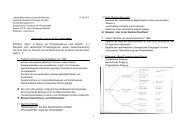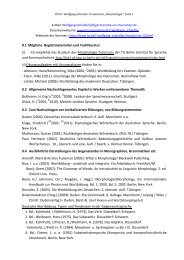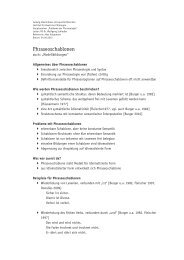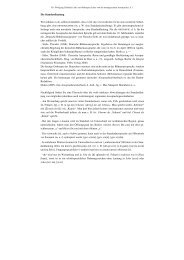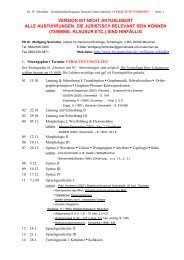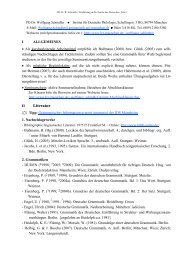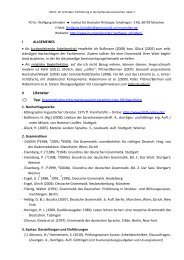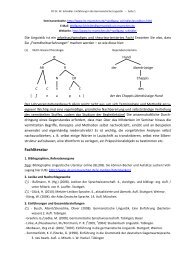Chapter 18 Lexical Functions: Description of Lexical Relations in a ...
Chapter 18 Lexical Functions: Description of Lexical Relations in a ...
Chapter 18 Lexical Functions: Description of Lexical Relations in a ...
You also want an ePaper? Increase the reach of your titles
YUMPU automatically turns print PDFs into web optimized ePapers that Google loves.
Anti - (hireV) = fireV [an employee]<br />
Anti - (beg<strong>in</strong>) = cease<br />
Anti > (high) = low<br />
Anti > (precede) = follow<br />
—<strong>Chapter</strong> <strong>18</strong>. <strong>Lexical</strong> <strong>Functions</strong>— 32<br />
Anti neg(stayV) = leave<br />
Anti neg(dead) = alive<br />
Anti opp(left) = right<br />
Anti opp(backN [human]) = belly<br />
In some languages, one <strong>of</strong> possible mean<strong>in</strong>gs <strong>of</strong> Anti - , namely, (undo the result <strong>of</strong> the<br />
preced<strong>in</strong>g action), i.e., (nullify the effect <strong>of</strong> what has been done before), is grammaticized as a<br />
morphological mean<strong>in</strong>g <strong>of</strong> reversive, a morphological form found, e.g., <strong>in</strong> Bantu languages, for<br />
<strong>in</strong>stance, <strong>in</strong> Swahili [the letter j stands for /z/]:<br />
fung-(a) (fasten) ~ fung+u-(a) (unfasten)<br />
kunj-(a) (fold) ~ kunj+u-(a) (unfold)<br />
tat-(a) (tangle) ~ tat+u-(a) (untangle)<br />
fumb-(a) (close) ~ fumb+u-(a) (open)<br />
teg-(a) (set trap) ~<br />
teg+u-(a) (release trap)<br />
va-(a) (put on clothes) ~<br />
v+u-(a) (take <strong>of</strong>f clothes)<br />
English has a similar formation, too: BUTTONV ~ UNBUTTON, LOCKV ~ UNLOCK, CLIPV ~ UN-<br />
CLIP, etc.; this formation is, however, not as productive and systematic as the reversive <strong>in</strong> Bantu.<br />
The LF Anti is also used with<strong>in</strong> the system <strong>of</strong> simple standard LFs, s<strong>in</strong>ce many such LFs<br />
stand to each other <strong>in</strong> the relation <strong>of</strong> antonymy: e.g., F<strong>in</strong> ≡ Anti(Incep), Magn vs. AntiMagn, etc.<br />
This will become clearer after the correspond<strong>in</strong>g LFs are <strong>in</strong>troduced.<br />
3. Conv kij [Lat. conversivum] = conversive<br />
Conversives correspond to the third important relation exploited <strong>in</strong> MTT: that between two<br />
equisignificant LUs whose DSynt-Actants do not correspond. More precisely, this LF returns for<br />
L an LU L´ with the same mean<strong>in</strong>g as L but with its DSynt-Actants [= DSyntAs] i, j and k<br />
permuted with respect to its Sem-actants, so that they become, e.g., the DSyntAs k, i and j [i→k,<br />
j→i, and k→j]. The relation <strong>of</strong> CONVERSION underlies the deep syntax <strong>in</strong> MTT. 11 For <strong>in</strong>stance, if<br />
L = PRECEDE and Conv 21(L) = FOLLOW ((A precedes B) = (B follows A)), we have:<br />
A<br />
I<br />
L<br />
II<br />
B<br />
!<br />
A<br />
Conv (L)<br />
21<br />
II I<br />
B


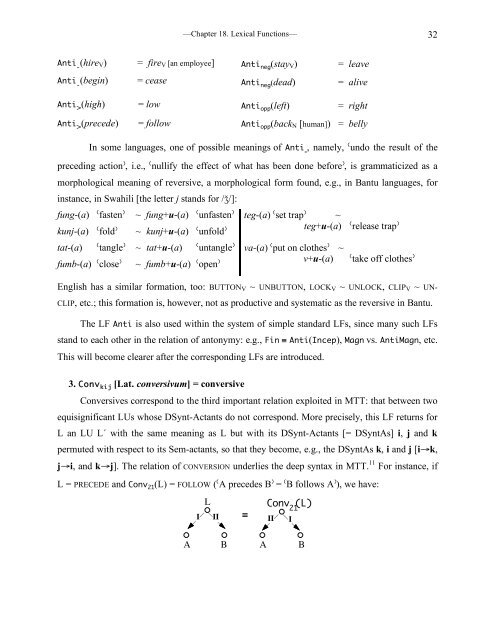
![E-Mail: Wolfgang.Schindler[ätt]germanistik.uni-muenchen.de Web ...](https://img.yumpu.com/51590147/1/184x260/e-mail-wolfgangschindlerattgermanistikuni-muenchende-web-.jpg?quality=85)
